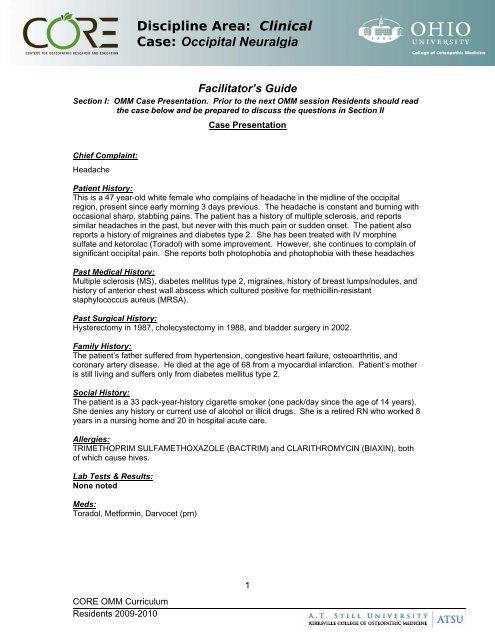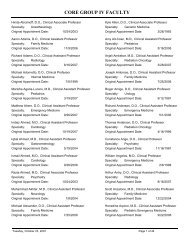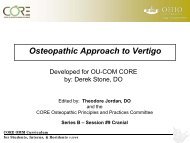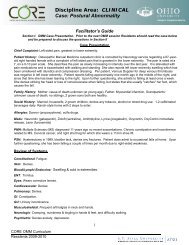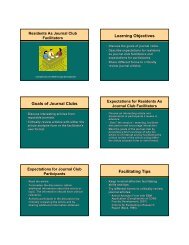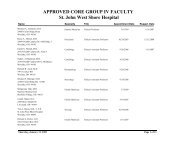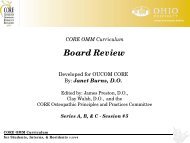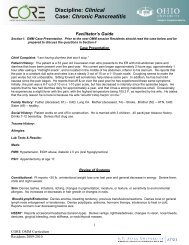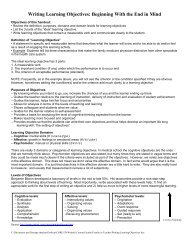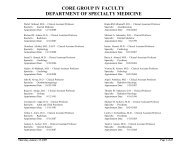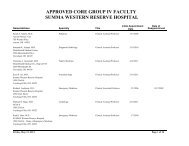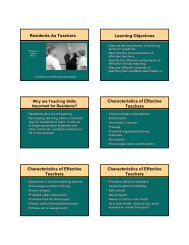Occipital Neuralgia
Occipital Neuralgia
Occipital Neuralgia
Create successful ePaper yourself
Turn your PDF publications into a flip-book with our unique Google optimized e-Paper software.
Discipline Area: ClinicalCase: <strong>Occipital</strong> <strong>Neuralgia</strong>Facilitator’s GuideSection I: OMM Case Presentation. Prior to the next OMM session Residents should readthe case below and be prepared to discuss the questions in Section IICase PresentationChief Complaint:HeadachePatient History:This is a 47 year-old white female who complains of headache in the midline of the occipitalregion, present since early morning 3 days previous. The headache is constant and burning withoccasional sharp, stabbing pains. The patient has a history of multiple sclerosis, and reportssimilar headaches in the past, but never with this much pain or sudden onset. The patient alsoreports a history of migraines and diabetes type 2. She has been treated with IV morphinesulfate and ketorolac (Toradol) with some improvement. However, she continues to complain ofsignificant occipital pain. She reports both photophobia and photophobia with these headachesPast Medical History:Multiple sclerosis (MS), diabetes mellitus type 2, migraines, history of breast lumps/nodules, andhistory of anterior chest wall abscess which cultured positive for methicillin-resistantstaphylococcus aureus (MRSA).Past Surgical History:Hysterectomy in 1987, cholecystectomy in 1988, and bladder surgery in 2002.Family History:The patient’s father suffered from hypertension, congestive heart failure, osteoarthritis, andcoronary artery disease. He died at the age of 68 from a myocardial infarction. Patient’s motheris still living and suffers only from diabetes mellitus type 2.Social History:The patient is a 33 pack-year-history cigarette smoker (one pack/day since the age of 14 years).She denies any history or current use of alcohol or illicit drugs. She is a retired RN who worked 8years in a nursing home and 20 in hospital acute care.Allergies:TRIMETHOPRIM SULFAMETHOXAZOLE (BACTRIM) and CLARITHROMYCIN (BIAXIN), bothof which cause hives.Lab Tests & Results:None notedMeds:Toradol, Metformin, Darvocet (prn)CORE OMM CurriculumResidents 2009-20101
Discipline Area: ClinicalCase: <strong>Occipital</strong> <strong>Neuralgia</strong>Respiratory: The lungs are clear to auscultation in the upper and lower fields bilaterally. Breathing isunlabored and there are no retractions or accessory muscle use.Diaphragm: Good movement bilaterallyGI: BS x 4, soft, nontender to palpationGU: DeferredMusculoskeletal: See Osteopathic exam below. Muscle strength is 5/5 and symmetric in the upper andlower extremities. Extremities are without focal sensory or motor deficits.Neurologic: Cranial Nerves II – XII are grossly intact without lateralizing signs. Deep tendon reflexes areslightly increased but are symmetrical in the upper and lower extremities.Lymphatic: No peripheral edema notedSection II: Focus of the Case (approximate time 20–30 minutes)Discussion Questions1. Propose an appropriate differentialdiagnosis / assessment2. What is your final diagnosis?Teaching PointsDifferential Diagnoses:1. C2–C3 subluxation/arthropathy2. C2–C3 radiculopathy3. Migraine headache4. Cluster headache5. Tension-type headache6. Tumor (e.g., posterior fossa)7. Cervicogenic Headache8. Congenital or acquired abnormalities at the craniocervical junction(e.g., Arnold-Chiari malformation or basilar invagination)9. Rheumatoid arthritis10. Atlantoaxial subluxation11. Cervical myelopathy12. Pott's disease/osteomyelitis13. Paget's diseasePrimary Diagnosis: <strong>Occipital</strong> neuralgiaSecondary Diagnosis: Tension headacheneck painMSDM Type IISomatic dysfunction related to diagnosis: Head, Cervical,Thoracic, and RibsCORE OMM CurriculumResidents 2009-20103
Discipline Area: ClinicalCase: <strong>Occipital</strong> <strong>Neuralgia</strong>3. How do you explain the currentstructural findings in the context ofthis case?Are any relevant structuralfindings missing?What would you do differently?Why?Somato-somatic reflexes, manifesting as myofascial changes andsomatic dysfunctions.Missing findings include muscle tightness in the trapezius anddeep musculature of the cervical/suboccipital region, andevaluation of the CRI, TMJ, and neck fascia.These areas need to be addressed4. What pathophysiology & functionalanatomy knowledge is pertinent fordiagnosing/treating this patientPathophysiology and Functional Anatomy The greater occipital nerve is the largest purely afferent nerve inthe body, innervating the posterior skull from the suboccipital areato the vertex. It is formed from the posterior division of the second cervical nerve. Within the substantia gelatinosa of the spinal cord, the afferentfibers from this nerve lie in close approximation to the nucleus andspinal tract of the trigeminal nerve. Rather than exiting through a discrete spinal foramen, the nerveleaves the bony spinal column between the arch of the atlas andaxis. It travels inferolaterally toward the area of the C2–C3zygapophyseal (facet) joint and then curves around the inferioroblique capitis muscle to ascend toward the occiput deep to thesemispinalis capitis muscle. It pierces either through the tendinous insertion of the trapeziusmuscle or between the trapezius and semispinalis muscles toreach the subcutaneous tissue of the occipital area. The site of perforation through these muscles is located just medialto the occipital artery.____________________________________________________________ The lesser occipital nerve forms from the anterior divisions of thesecond and third cervical nerves.It ascends along the posterior margin of the sternocleidomastoidmuscle, where it provides sensory fibers to the area of the scalplateral to the greater occipital nerve.5. What will be your highest yieldregions?6. How does previous trauma influencethese regions?Head, cervical, thoracic. and ribcage regionsThere is no recorded trauma history. However, trauma has to beconsidered as an inciting event.CORE OMM CurriculumResidents 2009-20104
Discipline Area: ClinicalCase: <strong>Occipital</strong> <strong>Neuralgia</strong>7. Which 1 or 2 of the aspects below hasthe greatest influence on the patientcomplaint? Pain Fluid congestion Hyper-sympathetic influence Parasympathetic influencePainFluid congestionAll of these aspects have significant influence on the primary complaint.All of them are also modified by the patient’s comorbidities.8. What are the acute or chronic aspects? Acute:headacheChronic:suffering from MS, DM, migraines, and any possible trauma history9. Devise an appropriate treatment planbased on musculoskeletal componentsinvolved in the patient complaintGoals for OMM Management: Physical and manual modes of therapy are important therapeuticmodalities for the acute rehabilitation of cervicogenic headache. A controlled trial testing the effectiveness of therapeutic exerciseand manipulative treatment for cases of cervicogenic headachefound that efficacy was not substantially affected by age, gender,or headache chronicity in patients with moderate to severe painintensity. This finding suggests that all patients with cervicogenicheadache could benefit from manual modes of therapy andphysical conditioning.The treatment plan could include:Osteopathic manipulative techniques such as craniosacral, straincounterstrain, and muscle energy techniques are particularly wellsuited for the management of cervicogenic headache.High velocity, low amplitude manipulation can be carefully used insome patients, though it is not unusual to observe an increase inheadache intensity after manual modes of therapy of this type,especially if it is delivered too vigorously.Physical treatment modalities are generally better tolerated wheninitiated with gentle muscle stretching and manual cervicaltraction.Therapy can be slowly advanced as tolerated to includestrengthening and aerobic conditioning. Using anestheticblockade and neurolytic procedures for temporary pain relief canenhance the efficacy and advancement of physical modes oftherapy.10. How soon would you see the patientfor OMM follow-up?A review of the medical literature suggested that the efficacy ofphysical treatment modalities for the long-term prevention andcontrol of headaches appears greatest in patients who areinvolved in ongoing exercise and physical conditioning programs.Dosing should be dependent upon patient response.CORE OMM CurriculumResidents 2009-20105
Discipline Area: ClinicalCase: <strong>Occipital</strong> <strong>Neuralgia</strong>11. What are the outpatient, inpatient, andemergency room considerations?See # 9 aboveThis is an outpatient case. It is important that the patient fullyparticipates in her care and undertakes the exercise and stretchingand strengthening regimens recommended to effect long-termchange and increase in function.12. How are you going to talk to yourpatient about their complaint and yourtreatment?With compassion and speaking in clear, easily understandableterms.Emphasize the patient’s partnership in her health careEmphasize a strong belief in the patient’s power to effect change,especially in consideration of the fact that her multiple sclerosismay cause her times of feeling powerless over her body13. How will you communicate yourfindings, diagnosis, and rationale for OMMtreatment to your preceptor?Clearly, concisely, with emphasis on pertinent positives andnegatives from medical, family, and social histories.Considerations for treatment options, management goals, andlong-term outcomes/prognosis.Any questions or concerns I have will also be addressed with myattending at that time.14. What coding and billing information forevaluation and management andprocedural services will yougenerate?(See Chart below) The diagnosis of somatic dysfunction in the assessment justifies theuse of OMT Somatic dysfunction diagnosis must be present in order to bill forthe OMT that was performed. OMT is considered a procedure. Documentation must reflect that the decision to perform OMT wasmade on that visit based on the physical findings and OMT wasused for somatic dysfunction(s) identified The procedure (OMT) and the E/M visit may both be billed with thesame diagnosis code and during the same encounter if the decisionto perform the procedure was made at the time of the encounter.Modifier -25 is used with the E/M codeYou must have a non-somatic dysfunction diagnosis included for this case15. How would you record your encounterand OMT on your patient care logs?Enter patient data, diagnosis date, and any specialcomments.CORE OMM CurriculumResidents 2009-20106
Discipline Area: ClinicalCase: <strong>Occipital</strong> <strong>Neuralgia</strong>99253- Inpatient Consultation-detailedCodeProcedure Services:Osteopathic Manipulative TreatmentDescription98925 Manipulation, 1-2 areasX 98926 Manipulation, 3-4 areasDiagnosis98927 Manipulation, 5-6 areas98928 Manipulation, 7-8 areas98929 Manipulation, 9-10 areasCPT Diagnostic Codes: Rank in order of ImportanceSomatic DysfunctionCode Description Code Description Code Description729.2 <strong>Occipital</strong><strong>Neuralgia</strong>307.81 TensionHeadacheX 739.0 Head 739.5 Hip/PelvisX 739.1 Cervical 739.6 LowerExtremity723.1 Neck Pain X 739.2 Thoracic 739.7 UpperExtremity739.3 Lumbar X 739.8 Rib739.4 Sacrum/Sacroiliac 739.9 Abdomen16. What is the Evidence Base?Biondi, David M. Cervicogenic Headache: A Review of Diagnostic and Treatment Strategies,J Am Osteopath Assoc, Apr 2005; 105: 16S - 22S.Frontera Essentials of Physical Medicine and Rehabilitation, 1st ed., Copyright © 2002 Hanley and Belfus)Search for the best evidence references:An appraisal of the osteopathic literature is critical to ensure the osteopathic paradigm is foremost in the philosophicalapplication of information to patient care. Search of relevant and associated data from the osteopathic literature:OstMed-Dr (http://www.ostmed-dr.com:8080/vital/access/manager/Index)Other literature bases (systems or synopsis engines):Poems (www.infopoems.com)Family Practice Inquiry Network (www.fpin.org)PubMedOvidGoogle ScholarSection III: Workshop/Lab (approximate time 60 minutes)7CORE OMM CurriculumResidents 2009-2010
Discipline Area: ClinicalCase: <strong>Occipital</strong> <strong>Neuralgia</strong>Facilitator demonstrates the key treatment techniques.1. Participants divide into groups at the table2. At each table, discuss and practice the appropriate palpatory diagnosis for this patient3. Facilitator demonstrates the key treatment techniques:4. Participants should practice the following techniques on each other:Craniosacral, strain-counter strain, and muscle energy techniquesGentle muscle stretching and manual cervical traction.5. At each table, while the techniques are being practices:a. Identify and practice good body mechanics for the physician and patient intreatmentb. Discuss the treatment planc. Discuss what palpatory findings should change on the patient after OMMtreatment6. DocumentationResidents demonstrate an appropriate documentation of this case including findings andtreatment here...Section IV: Final Wrap-up and Questions/AnswersCORE OMM CurriculumResidents 2009-20108


